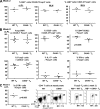OX40 is required for regulatory T cell-mediated control of colitis
- PMID: 20368580
- PMCID: PMC2856021
- DOI: 10.1084/jem.20091618
OX40 is required for regulatory T cell-mediated control of colitis
Abstract
The immune response in the gastrointestinal tract is a tightly controlled balance between effector and regulatory cell responses. Here, we have investigated the role of OX40 in influencing the balance between conventional T cells and Foxp3+ regulatory T (T reg) cells. Under steady-state conditions, OX40 was required by T reg cells for their accumulation in the colon, but not peripheral lymphoid organs. Strikingly, under inflammatory conditions OX40 played an essential role in T reg cell-mediated suppression of colitis. OX40(-/-) T reg cells showed reduced accumulation in the colon and peripheral lymphoid organs, resulting in their inability to keep pace with the effector response. In the absence of OX40 signaling, T reg cells underwent enhanced activation-induced cell death, indicating that OX40 delivers an important survival signal to T reg cells after activation. As OX40 also promoted the colitogenic Th1 response, its expression on T reg cells may be required for effective competition with OX40-dependent effector responses. These results newly identify a key role for OX40 in the homeostasis of intestinal Foxp3+ T reg cells and in suppression of colitis. These fi ndings should be taken into account when considering OX40 blockade for treatment of IBD.
Figures






References
-
- Bennett C.L., Christie J., Ramsdell F., Brunkow M.E., Ferguson P.J., Whitesell L., Kelly T.E., Saulsbury F.T., Chance P.F., Ochs H.D. 2001. The immune dysregulation, polyendocrinopathy, enteropathy, X-linked syndrome (IPEX) is caused by mutations of FOXP3. Nat. Genet. 27:20–21 10.1038/83713 - DOI - PubMed
Publication types
MeSH terms
Substances
Grants and funding
LinkOut - more resources
Full Text Sources
Other Literature Sources
Medical
Molecular Biology Databases
Research Materials

